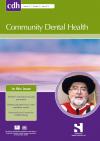Community Dental Health

- Cover Date:
- June 2015
- Print ISSN:
- 0265 539X
- Vol:
- 32
- Issue:
- 2
Association between dental status and food diversity among older Japanese
© BASCD 2015 doi:10.1922/CDH_3502Iwasaki07
Association between dental status and food diversity among older Japanese
M. Iwasaki, Y. Kimura, A. Yoshihara, H. Ogawa, T. Yamaga, T. Takiguchi, T. Wada, R. Sakamoto, Y. Ishimoto, E. Fukutomi, W. Chen, H. Imai, M. Fujisawa, K. Okumiya, M.C. Manz, H. Miyazaki and K. Matsubayashi
Objective: To investigate the relationship of dental status to food diversity among older Japanese. Design and Setting: A community-based cross-sectional study conducted in the town of Tosa, Kochi Prefecture, Japan. Methods: The study participants were 252 Japanese (84 men and 168 women, average age 81.2 years) and dentate participants were classified into three groups: 1-9 teeth, 10-19 teeth and 20 or more teeth. Food diversity was assessed as a validated measure of dietary quality using the 11-item Food Diversity Score Kyoto (FDSK-11), which evaluates frequency of consumption of 11 main food groups. Multivariable analysis of the differences in FDSK-11 score ranging from 0 to 11, with a higher score indicating greater food diversity, among the three dental status groups was conducted using general linear models. All the performed analyses were stratified by gender. Results: There was no association between dental status and food diversity score in models for men. In contrast, women with ≤9 teeth and with 10-19 teeth had significantly lower FDSK-11 scores than women with ≥20 teeth after adjusting for confounders (p<0.001 and p=0.009, respectively). Additionally, there was a trend toward lower scores for FDSK-11 with fewer teeth (p=0.001). Conclusion: A less varied diet, as indicated by low FDSK-11 score, was observed in female participants with fewer teeth. Tooth loss was associated with poor diet quality among older Japanese women.
Key words: epidemiology, aged, diet, food diversity, tooth loss, cross-sectional studies, Japan
- Article Price
- £15.00
- Institution Article Price
- £
- Page Start
- 104
- Page End
- 110
- Authors
- M. Iwasaki, Y. Kimura, A. Yoshihara, H. Ogawa, T. Yamaga, T. Takiguchi, T. Wada, R. Sakamoto, Y. Ishimoto, E. Fukutomi, W. Chen, H. Imai, M. Fujisawa, K. Okumiya, M.C. Manz, H. Miyazaki, K. Matsubayashi
Articles from this issue
- Title
- Pg. Start
- Pg. End
- Dentists’ knowledge of oral health during pregnancy: a review of the last 10 years’ publications
- 77
- 82
- A pilot project to improve the oral health of orphans and of the elderly in residential care in Constanta, Romania
- 89
- 92
- The association between parents’ perceived social norms for toothbrushing and the frequency with which they report brushing their child’s teeth
- 98
- 103
- Are Stage of Change constructs relevant for subjective oral health in a vulnerable population?
- 111
- 116
